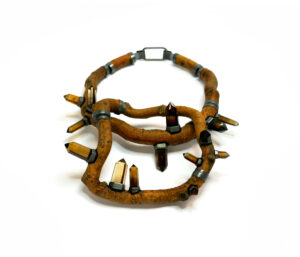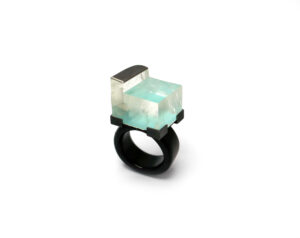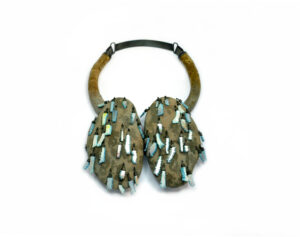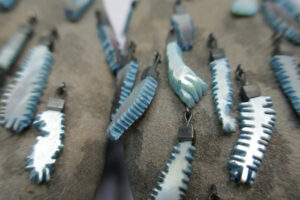Episode 222
What you’ll learn in this episode:
- How Terhi’s work changed as she moved from Finland to Amsterdam to France
- How the weather influenced Terhi’s recent exhibition at Ornamentum Gallery
- How jewelry can help us explore the relationship between man and nature
- Why Terhi creates her work on a mannequin, and how she lets materials tell her what they want to be
- Why love is the most important thing an artist can put in their work
About Terhi Tolvanen
Currently based in the French countryside, Terhi Tolvanen was born in Helsinki, Finland (1968). Following studies at the Lahti Design Institute, Finland, and the Gerrit Rietveld Academy, NL, Tolvanen earned a Master’s Degree in Jewelry at the Sandberg Institute, Amsterdam, NL.
Tolvanen’s works can be found in numerous distinguished private and public collections worldwide, including the Swiss National Museum, the Victoria & Albert Museum (London, UK) the Dallas Museum of Art (TX- USA) among others.
Photos:
“Wild frontal”

“Illution of Space”

“Breathing Rocks”

“Breathing Rocks detail”

“Big Pearl Bloom detail”

“Big Pearl Bloom”

Additional Resources
Transcript:
Terhi Tolvanen’s jewelry isn’t made of gold or diamonds, but in its own way, it’s just as precious. The Finnish jeweler uses natural materials like wood, raw minerals and shells to create jewelry that not only looks beautiful, but challenges viewers to reflect on the world around them. She joined the Jewelry Journey Podcast to talk about how her daily walks shape her work; how living in Amsterdam and rural France have changed her jewelry over the years; and her advice for emerging artists. Read the episode transcript here.
Welcome to the Jewelry Journey, exploring the hidden world of art around you. Because every piece of art has a story, and jewelry is no exception.
Sharon: Hello, everyone. Welcome to the Jewelry Journey Podcast. This is the second part of a two-part episode. If you haven’t heard part one, please head to TheJewelryJourney.com.
We’re so glad you’re here today. I’d never heard of our guest, Terhi Tolvanen, before. I don’t know how I missed her jewelry because I like large, statement-type pieces, and that’s what many of Terhi’s pieces are. I was really taken with them. Welcome back.
Sharon: So, it’s finding things in nature that you put together in what you call a sculpture.
Terhi: Yeah, sculpture, jewelry. I do really make jewelry, but it’s also all these wonderful materials that I manage to find. I’m also talking about, for example, light and movement. How do the trees, for example, move in the wind? This can be a big inspiration. Or an early summer rain, which gives a certain kind of light and color to things. I also have very many pieces where I’m talking about the metamorphosis of a flower, opening and being in full flower and then in the end fading away. The circle of life.
I’m very fond of moss also, which I find very beautiful. It also talks about time because moss is growing very slowly, and it takes over places that have not been really taken care of. What is taken care of? There are cultures, like in Japan, where they think moss is very important and beautiful. They pour sour milk over stone so that moss would grow better. Whereas in Europe the moss is taken away. They have pieces where, for example, it’s a moss collection. I made my own moss, or I make my own mushrooms, which are also very fascinating.
Sharon: So, nature is where you get most of your inspiration from. From the things around you that other people might overlook?
Terhi: Yes, it’s that. Yes, I think so. The starting point is a little bit in this experience that I had when I moved to Amsterdam. In Finland, it’s so normal for everybody to have nature around, and it’s so very normal to go to the forest and to be able to pick berries and mushrooms and walk around. When I moved to Amsterdam, I realized that this is not at all the case over there. Everything is planted. Nothing is wild. Even the forest is planted, and you should not touch anything. So, the nature experience is totally, totally different. This was not really shocking to me, but I found it very interesting at the time.
I think it’s really a human need to be in touch with nature, and in a city situation, it starts on the balconies. The very first pieces I made after school were about flowerpots and balconies where people are creating their own nature spaces in a mini way. I found that very interesting. When one has a little bit more space, this becomes a garden, and there are all different kinds of gardens, very well taken care of or very wild gardens.
I’m also very fond of all different garden wood. The best material for me is, for example, this curly hazelnut that has been pruned for many years, which makes it curl even more. This human interaction has been there already long before I get to this material in my hands. There are all kinds of fascinating situations with these thoughts.
Sharon: Are people surprised when they look at your work, like, “What is this? This isn’t jewelry. There’s no diamonds or gold.” What is their reaction?
Terhi: Yeah, sometimes. I don’t have so many new people around that I get to hear this kind of remark. But yeah, sometimes it happens like, “Really? It’s very big and it must be very heavy.” They find it very strange that branches can make a necklace. I have the feeling that the big question is “But where is the value?” It’s easier to see the value when it’s precious metal and shiny stones.
Sharon: How do you introduce yourself to people who don’t know you? If people ask what you do, what do you tell them?
Terhi: I say I’m a jewelry artist, and then I have to explain. I say I’m a jewelry artist making contemporary jewelry because there are so many different types of jewelry. I have to explain that I’m selling my work through galleries and that there are collectors and museums buying, like it was any other art discipline like painting or sculpture. This explains the best, I think, the way I do work.
Otherwise, a remark I get very often is, “The Christmas market is very nice in that little town. Maybe this would be interesting for you.” Then I have to explain that I don’t make pieces in series. My pieces are always unique pieces. I make some variations, but I never really copy a piece. There are some exceptions to the rule, but I haven’t done it many times.
Sharon: You’re in many prestigious museums around the world. That must give you a lot of credibility when you’re talking to people.
Terhi: Yes, of course. This is really fantastic, that my work is valued. It’s very good for motivation, and, of course, it gives status. It’s fantastic to be appreciated in my work. It’s quite important. I would say it’s very important for me, yes.
Sharon: It keeps you going. The first time a museum wanted to collect your work, did they come to you? Did they see it at a show? What happened?
Terhi: The museums and collectors are buying from the galleries, so I am not in direct contact with them. With the years, I have gotten to meet some of my collectors. I have quite a few in the U.S., and this is very far away. So, there are some I have never met in person. I would say I’ve met more in Europe at the openings. It’s very nice and important to be there for my own openings and especially to meet people.
Sharon: Were you excited or inspired when you heard the museum bought your first piece or your second piece? Did it keep you going?
Terhi: Yes, absolutely. Yes. I have quite a good list now. I have a couple of museums I would like to have my pieces also, so I still have work to do.
Sharon: You mentioned that you’re very busy in the studio right now. What are you working on?
Terhi: Yes, I’m always very busy. The whole year is a rhythm with solo exhibitions. For quite some years now, there’s a solo exhibition in one of my galleries every year. Then I have galleries that go regularly to fairs, and I try to have some new pieces for them. Right now, I’m finishing pieces for the Pearl Exhibition at Noel Guyomarc’h in Montreal. The Pearl Exhibition is touring now in several galleries, and then each gallery is asking other artists to participate. Noel asked me, among others. Then I’m also preparing some pieces for an art fair in Amsterdam. I’m also almost done with a customer order from Ornamentum Gallery.
Sharon: Would you say the market for jewelry is growing in France, or is it remaining stable?
Terhi: Well, it’s quite stable, I would say, for quite some time now, which means in practice that I can’t really work with any new galleries on a steady basis. I do participate in group exhibitions, of course, but I have four galleries now that I work with, and they wait all the time for new pieces. So, I’m full in work all the time.
Sharon: That’s a nice position to be in. At what point do the stones talk to you to say, “I’m going to be a necklace,” or I should be a ring or a bracelet”?
Terhi: Yeah, absolutely the materials talk to me. I’m a very materialistic maker in that sense. The materials are extremely important for me. This was already the case from the beginning. I’m only getting better in it, I think, and a little bit quicker. The way it goes is that I often let the wood—the branches that have certain shapes, I let them decide what shape the necklace would be. They tell me how they would be. There is a way in this puzzle work that when they are arranged in the best way, they also talk about movement or waves or so on.
The same thing with stones. For example, when I have a mineral, I carefully choose which side of this mineral I show, which is the front side, because there are differences. The back side is maybe not so nice. The color is maybe better from a certain angle. A lot also decides where I need to place the stones. For example, labradorite is very dependent on the light falling on the stone. When it is looked at from a certain direction, it gives this very strong blue and green light in the stone.
This is why I turn them around. Because jewelry pieces are three dimensional when they’re worn, I’m making my pieces on the mannequin. When I’m moving around my mannequin, I’m taking care that the stones are having light from all sides of the piece. It cannot be only from the front because a jewelry piece is never looked at only from the front.
I let the material decide a lot. With time I have learned to see. I’m really looking for certain qualities in the material. There are certain stones that absolutely need to be a ring because the stone is the most beautiful or spectacular or gives its best when it’s placed on the hand, where one can look at it and turn it around a little bit.
Sharon: Now, you’ve been doing this for about 20 years at least. What would you say to people who are just starting out? What would you tell emerging artists?
Terhi: I would tell them that when making, they have to give all the love they have to their work. This means that one needs to try to do his or her best every time because one cannot cheat on that. When you put all your soul and all the love you have into your piece, then it becomes a good piece. Love means it’s a good work because all artists are responsible for the quality of their work. In today’s world, where there are so many objects, so many things that we don’t need, what justifies the fact that art needs to exist? We have to do our best to make only really good pieces. This is possible when you give a lot of love. How do I know if my piece is ready and good? I, myself, find the piece really having a presence.
Sharon: So, that’s what emerging artists or all artists should work towards.
Terhi: Yes, I think this is very important. With time, when they manage to concentrate on this question, at the same time, the technical skills and everything around it will develop as well.
Sharon: Well, thank you very much for talking with us today, Terhi. I hope we have a chance to do it again in the future.
Terhi: Thank you so much, Sharon, for having me. It was great.
Sharon: We will have photos posted on the website. Please head to TheJewelryJourney.com to check them out.
Thank you again for listening. Please leave us a rating and review so we can help others start their own jewelry journey.

